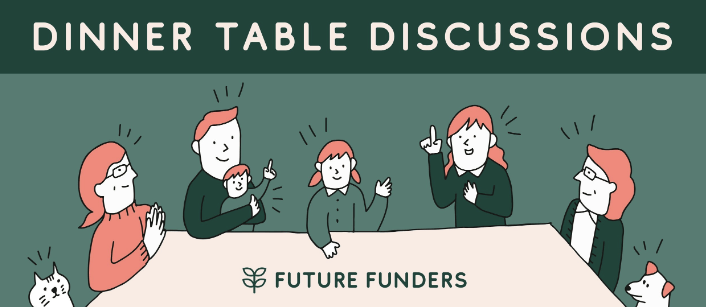📢 A Message from our Sponsor
Pay No Interest Until Nearly 2027 AND Earn 5% Cash Back
Some credit cards can help you get out of debt faster with a 0% intro APR on balance transfers. Transfer your balance, pay it down interest-free, and save money. FinanceBuzz reviewed top cards and found the best options—one even offers 0% APR into 2027 + 5% cash back!

Welcome back, Future Funder!
The legend of Robin Hood—stealing from the rich to give to the poor—has enchanted generations. But beneath the romanticized tale lies a deeper, more complex story about wealth redistribution, economic inequality, and the values that shape societies.
Today, we’ll uncover:
The origins of Robin Hood’s legacy and its enduring appeal.
The economic implications of wealth redistribution through the ages.
The real costs of “Robin Hood economics,” from medieval society to modern fiscal policies.
Lessons on balancing equity and economic efficiency in today’s world.
Robin Hood’s story may be timeless, but the debate over fairness and redistribution is as modern as ever.
Bon a petit! 🧑🍳
🍽️ Main Course: 🏹 The Legend and Its Economic Implications

It’s no secret that the distribution of global wealth is profoundly unequal. Wealth—which includes the marketable value of financial assets and non-financial assets like housing and land (minus debts)—is concentrated in the hands of a tiny elite.
Did you know? Less than 1% of the world’s population owns the majority of this wealth.
(Image credit: World Economic Forum)
Robin Hood’s tale shines a spotlight on this imbalance. By symbolizing wealth redistribution, his story challenges the stark disparities between the privileged and the underprivileged. This enduring legend brings forward some of the most complex and controversial economic questions:
Is it justifiable to take from the rich to support the poor?
What are the economic impacts of redistribution policies?
How do such actions align with or challenge moral frameworks?
Robin Hood’s bow may not solve the inequality crisis, but his story forces us to grapple with fairness, ethics, and the structure of our economic systems.
💰 Modern-Day Parallels: Redistribution in Action
In today’s world, the “Robin Hood effect” plays out through wealth redistribution mechanisms like taxation and social welfare programs. These modern tools aim to reduce economic disparities, but their effectiveness and public support vary widely.
Key Insights:
Public Perception:
Studies show that many Americans favor some level of economic inequality over aggressive wealth redistribution.
This suggests a complex relationship between societal values and the idea of fairness in economic policies.
Policy Implementation:
Governments employ progressive taxation (higher taxes on the wealthy) and social programs to address income gaps.
These measures aim to balance wealth distribution without hindering economic growth.
However, despite these efforts, significant progress on reducing disparities remains elusive.
The Robin Hood effect isn’t just about economics—it’s about balancing the fine line between equity and incentives, fairness and growth.
🎁🏛️ The Robin Hood Paradox
The Robin Hood paradox highlights the puzzling phenomenon of limited wealth redistribution, even as inequality continues to rise. Despite democratic systems and public awareness, wealth remains concentrated, and significant redistribution efforts often fall short.
Key Contributing Factors:
Political Dynamics:
Democracies don’t always implement “Robin Hood” policies, even in the face of rising inequality.
Scholars attribute this to:
Institutional legacies rooted in historical systems that favor the wealthy.
Limitations of democratic tools like progressive taxation or enforcement of wealth redistribution policies against elite resistance.
Economic Considerations:
Policymakers weigh the potential risks of redistribution, including its impact on economic growth.
Redistribution policies can be seen as potentially harmful, drawing comparisons to stagnation under communism.
However, inequality can also hurt economic growth when:
Politicians dictate redistributive policies for personal or partisan advantage.
Property rights are disproportionately tilted towards the rich.
Credit markets fail due to inefficiencies or lack of transparency.
A narrow consumer base slows industrial growth and innovation.
Political and economic volatility discourages long-term investments.
The paradox reveals a tension: while redistribution is often seen as a moral and economic necessity, systemic challenges and fears of economic stagnation keep it elusive.
🌐 Global Perspectives: Welfare States and Redistribution
Countries around the world have developed distinct approaches to wealth redistribution, balancing societal values, economic efficiency, and equity. These methods reflect varying priorities and philosophies about fairness and economic incentives.
1. Welfare States: Lifecycle Redistribution
The Approach:
Countries with strong social safety nets use a “piggy bank method” of redistribution.
This involves inter-age-group resource transfers where surplus resources from working-aged citizens are taxed to support:
Childhood needs (education, healthcare).
Old age benefits (pensions, social care).
The Goal:
To provide stability and security throughout citizens’ lives, ensuring that all age groups are supported during financially vulnerable periods.
2. Tax Policies: Equity vs. Efficiency
The Balancing Act:
Tax systems are crafted to balance equity (reducing inequality) and economic efficiency (maintaining growth and incentives).
A well-designed tax system reflects societal preferences and willingness to redistribute wealth.
Example – Washington State’s Proposition 1098:
This initiative proposed redistributive taxation, highlighting how:
Economic self-interest and inequality concerns shaped public support.
Partisanship played a significant role in influencing preferences.
Findings suggest that when policies clearly outline their distributional impact, citizens align their attitudes and votes with self-interest and broader values.
Global approaches to redistribution reveal a common thread: balancing fairness and function is key to crafting policies that work for society at large.
🧠 Economic Theories and Debates
The topic of wealth redistribution is a focal point in economics, sparking debates over its benefits, drawbacks, and long-term effects. Here are two central perspectives:
1. The Robin Hood Principle
Core Idea:
This principle proposes that transferring wealth from the rich to the poor can enhance overall societal welfare.
Redistribution provides disadvantaged groups with greater access to resources, potentially reducing inequality and improving quality of life.
Challenges:
Practical application involves navigating complex variables, such as:
Determining the optimal level of redistribution.
Balancing equity and incentives for productivity and innovation.
Excessive redistribution risks diminishing economic motivation among both the wealthy and the working class.
2. Growth Implications
Inequality and Growth:
The relationship between inequality and economic growth is highly nuanced:
Pro-Redistribution: Moderate redistribution can stabilize societies and promote development, creating a stronger middle class and broader consumer base.
Anti-Redistribution: Critics argue that heavy redistribution may stifle economic growth by reducing investment and entrepreneurship.
The Balance:
Economists suggest that well-calibrated redistribution policies—neither overly aggressive nor absent—can boost stability and foster long-term growth.
The economic debate boils down to one question: how do we redistribute wealth to reduce inequality without undermining the engines of growth?
🔍 Key Takeaways
Wealth redistribution is a deeply nuanced issue influenced by interrelated economic, political, and social forces. Here’s a summary of the most important points:
1. Complex Dynamics
Wealth redistribution is not a one-size-fits-all solution.
It involves balancing multiple factors, including:
Economic efficiency
Political feasibility
Social equity
2. Societal Values Matter
Cultural attitudes toward inequality and fairness significantly shape public support for redistribution.
Societies with stronger preferences for equity tend to back policies that narrow income and wealth gaps.
3. Policy Design is Crucial
Successful redistribution policies must:
Be carefully crafted to minimize economic disruptions.
Align with societal goals like reducing poverty or fostering equal opportunities.
Consider potential growth implications, ensuring they don’t hinder innovation or productivity.
The art of wealth redistribution lies in finding the sweet spot where fairness and functionality coexist.
The legend of Robin Hood provides a timeless and thought-provoking framework for exploring modern debates on wealth redistribution. While the romanticized idea of "taking from the rich to give to the poor" holds emotional appeal, its real-world application requires grappling with:
Complex economic theories that weigh equity against growth.
Diverse political ideologies that shape policy implementation.
Societal values that influence public support and perceptions of fairness.
Redistribution may seem simple in concept, but in practice, it’s a maze of competing priorities and interconnected challenges.
Cheers to getting 1% better each week! 🥂
📢 A Message from The Daily Upside
What Top Execs Read Before the Market Opens
The Daily Upside was built by investment pros to give execs the intel they need—no fluff, just sharp insights on trends, deals, and strategy. Join 1M+ professionals and subscribe for free.
🧙♀️ Your wish is our command
What did you think of today's email?
Thanks for reading.
Until next time!
Your friends @ Future Funders 🍽️
p.s. If you liked this newsletter, share it with your friends and colleagues here.

